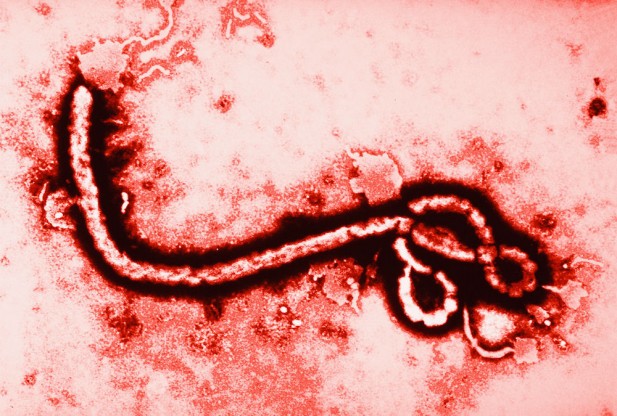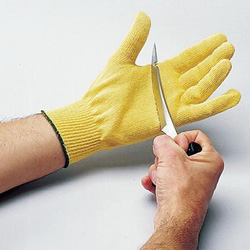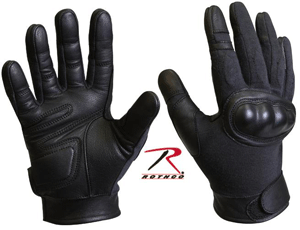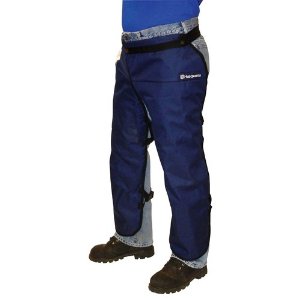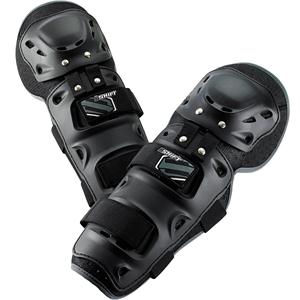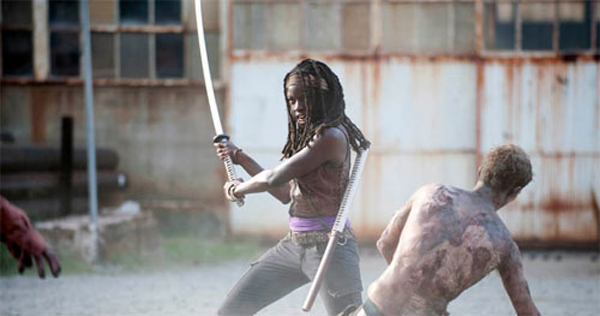
Disclaimer: The use of weapons below may be considered rather gruesome and graphic, and is not suitable for children under 13. This post discusses about an unlikely but a possible scenario of a zombie infested apocalypse, and all suggestions should be taken with a grain of salt. That said, all weapons are dangerous and deadly, and should be practiced with professional supervision. In such a scenario and in all survival scenarios, all weapons require skill and proficiency to be used effectively, whether combating zombies or ‘bad guys’. Always abide by local laws and law enforcement when acquiring or practicing with weapons. Always find an avenue of escape before engaging in combat, for all combat in reality can have deadly outcomes. If at all possible, find higher ground that is difficult to reach by zombies, and easy to defend for you. Always wear protective gear if available. Safety eyewear is recommended when operating ranged weapons, and when engaging zombies in melee combat to protect eyes from gun powder discharge, flying debris, dust, and zombie bodily fluid spray. This post assumes that zombies are people who were infected by some kind of virus or bacteria or chemical agent that turns them into ravenous flesh eating creatures, whose bite or bodily fluids can infect humans and turns them into the said creatures.
Zombies, zombies, everywhere. It’s the zombie apocalypse. If you have survived the initial shock of the zombie apocalypse, now it’s time to make a break for safer ground. If you already have the Zombie-Proof Protective Suit (Zip Suit), then you are one of the lucky few one-in-a-million that has prepared for just this type of apocalypse. But the Zip suit is just a passive protection. You will be called upon or the need may fall upon your shoulders to dispatch a few zombies to make a break, or make your homestead safer. In order for that task to succeed, you’ll need some weapons prepared for such a situation.
Here are the top 10 must-have weapons for the zombie apocalypse, inspired by Max Brook’s Zombie Survival Guide. This top 10 list is my personal pick, and in my opinion, are the must-have weapons best suited against zombies.
I will break up the weapons into to 5 melee weapons and 5 ranged weapons. Melee weapons are for close quarters encounters, and ranged weapons are for longer distance attacks. The listed items are all my personal favorites, and what I consider to be the most efficient use of force and ammunition and funds. Bear in mind these weapons are hand-held weapons that can be carried by any adult with average strength or a teenager with above average strength, and can be acquired by an average American civilian. I will not include improvised weapons.

Examples of improvised weapons, which I will not be discussing in this post.
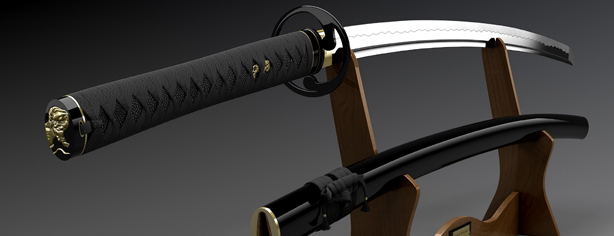
A modern Katana: sharp and deadly.
Top 5 Melee Weapons
- Gurkha Kukri* (10″+ high carbon steel blade, handmade, genuine gurkha kukri)
- Katana** (25″+ long high carbon steel blade, handmade, battle ready)
- Spear (36″ + long shaft with a 6″ long high carbon steel spear head, battle ready)
- Naginata (60″ long shaft with a 14″ + high carbon steel blade, handmade, battle ready)
- Tomahawk – throwing axe (18″-24″ shaft with 3″ + high carbon steel cutting axe head, battle ready)
I’ve chosen melee weapons that don’t require much brute force, and are simple to use. For example, a baseball bat or a crow bar requires brute force to the head of the zombie for it to be effective. A slashing or a piercing weapon concentrates the pressure point to a very small area, and is a much more efficient use of physical force. Instead of hitting a zombie on the head, which is a hard target, you can decapitate it, or remove limbs and make it less of a threat to you. A spear or a tomahawk can be thrown at a target several yards away. A Naginata would be perfectly suited against fighting zombies and keeping them at bay in large open areas. A katana is perfectly suited for clearing a room full of zombies, but a gurkha kukri can be great for clearing zombies in much narrower passageways or smaller enclosed areas with less room to swing. The gurkha kukri’s design allows it to be used like an axe to chop as well as slash at targets.
Note on Chainsaws: There are several reasons for not including a chainsaw as a weapon of choice on my melee weapon list. 1) It is an improvised weapon. 2) It requires gasoline, which isn’t always available. (And electric models require a power cord and electricity) 3) It is noisy as hell, which will attract unwanted attention. 4) It is heavy and hard to control in combat. 5) It has a lot of vibration which makes it harder to hold on for more than a few minutes at a time. 6) It requires a start of the engine which doesn’t always start when it is needed. 7) It has too many moving parts, and requires maintenance, and knowledge of machinery, and prone to break down. For all of the above, it makes a poor weapon of choice, no matter how much it is popularized in fiction and movies.
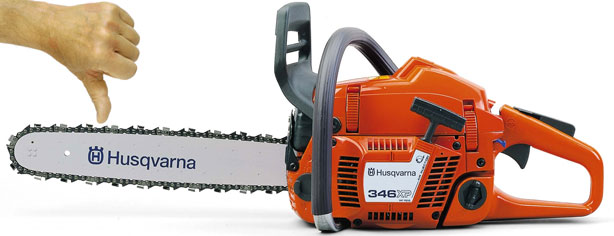
Chainsaws in general are not suitable for combating zombies, not just the Husqvarna chainsaw model shown here. I have nothing against Husqvarna – they make good hardware for lawn and gardening, and they make good protective gear.
Notes on buying
Gurkha Kukri*: The genuine gurkha kukri blade is hand forged and made from high carbon steel, and comes from Nepal, where the Gurkha warriors originate from. Don’t buy the “Resident Evil” movie style blades – these are knockoffs. If it is called a kukri machete, it is not a true kukri – don’t bother buying it. Any full sized kukri (10 – 12″) under $40 is likely to be a machine made knockoff, and anything over $100 is too expensive for a kukri. The genuine Nepalese blades are actually cheaper than the machine forged Cold Steel blades, and are thicker and sturdier. The spine (back of the blade) is about 1/4″ thick, and it is a heavy blade with weight emphasis on the forward 1/3 of the blade. My favorite gurkha kukri maker is GK & CO. Kukri House in Nepal. They are the real deal, and these kukri are nearly indestructible. I have several of those in various styles and lengths. This British Gurkha AEOF Afghan issue is my favorite – it is well balanced and extremely sharp. Notice the full tang, which extends past the handle – from the tip of the blade to the pommel, it is a one continuous piece of high carbon steel. Proper supervision is recommended.
Learn how to fight with a Kukri properly: The Fighting Kukri: Illustrated Lessons on the Gurkha Combat Knife by Dwight McLemore, a retired combat arms officer with the U.S. Army, and an accomplished bladesman and instructor with 18 years experience in self defense and martial arts.
Warning: Kukri Handling
Drawing a kukri out from its scabbard can be dangerous if not done the right way. One needs to hold the scabbard only at its back, the fingers never circling the whole case. Then with the firm grip one needs to pull out the kukri from its case making sure the back of the blade is at the back of its case never letting its sharp edge touch the leather. And with the same way must the kukri be kept inside.
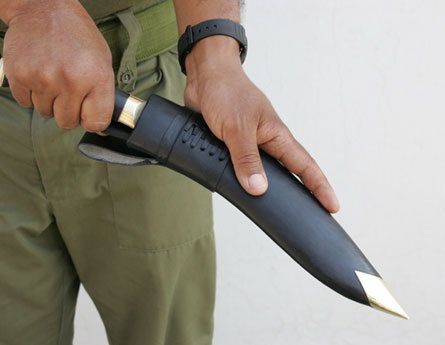
YouTube Video: Kukri vs. Zombie – by Zombie Go Boom YouTube Video – A Kukri test cutting using an anatomically correct ‘human head’. Next: Comparison between a Cold Steel Kukri Machete and a Nepalese Kukri. Kukri Review: GK&CO. Genuine Kukri Afghan AEOF
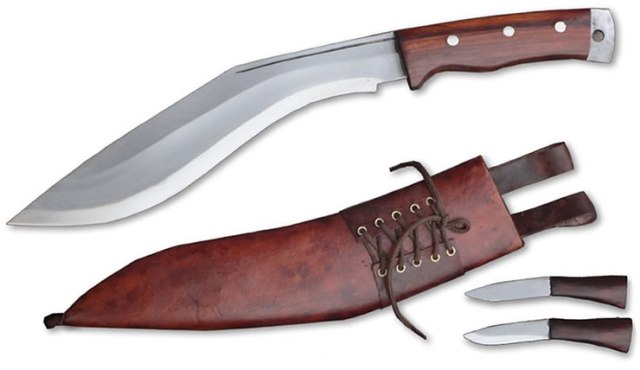
A British Gurkha AEOF Afghan issue Kukri
Katana**: The samurai’s iconic sword – the legendary katana – is now available in battle ready versions that won’t bankrupt you. You do not need to spend $500 or more. You can get a decent battle ready katana for a few hundred dollars. Do not buy the cheap ‘paper cutters’ under $100 – they are ‘toys’, and will break – you can’t depend on them in battle. Do not buy movie props or collector swords either. You don’t need the flashy and ornate designs either when you get a battle ready katana – just get the no-frill design, unless you are planning to hang it on the wall, or are planning to sell it on eBay. I prefer these no frill ‘tactical‘ designs since they come wrapped with para cord, so it’s a plus. Both the full sized tactical katana and the shorter tactical wakizashi are built solid and battle ready, and are sharp enough to decapitate a zombie. Notice the full tang that is the same length and shape as the rubberized handle. After slaying many zombies, you’ll want a sword that cleans easily. The Tactical Katana is $199, and the Tactical Wakizashi is $149, so they are a good fit for the budget. Here’s an idea; instead of getting a $500 Katana, why not get two of these Tactical ones instead which are as sharp and durable as the $500 weapon, for less? Remember: “Two is one, and one is none”. Make sure you remove the paracord wrap before use, from both the scabbard and the handle – it can get tangled up and ‘put you in a bind’ for some trouble.
Learn how to fight with a Katana like a real Samurai: Samurai Swordsmanship: The Batto, Kenjutsu and Tameshigiri of Eishin-Ryu by Masayuki Shimabukuro, the Grandmaster of Japanese swordsmanship.
YouTube Video: Katana vs. Zombie – by Zombie Go Boom – YouTube Video – Katana test cutting using an anatomically correct ‘zombie skull’.
Warning: Dispel the myth that the katana can cut through steel armor. Don’t try it, unless you want to ruin your blade. And don’t use it for cutting trees down or chopping wood – it will ruin your blade. And don’t even think about cutting a cinder block in half. Use the proper tool for the task – use an axe or a kukri for chopping wood, and a demolition hammer for destroying cinder blocks. A katana is made for cutting through flesh and bone, and it should do just that, and no other.
Note on maintenance: You don’t need to polish the blade. Just wipe off the blood and gore after use each day, and keep it well oiled with machine oil or WD-40, and it won’t rust. The same tip on maintenance applies to all the other carbon steel weapons, and you can use the same type of oil as well. There is no need to buy fancy sword oils or polishing powders and equipment – these are for display or heirloom swords, not for a battle sword. If you already have it, then, fine, use it, but you don’t need to go out of your way to get it.
Notes on using machetes: The machete is designed to be a cheap and effective general tool for clearing bush, and great for general survival and bush craft. That said, yes, you can use a machete as an improvised weapon to cut off a zombie’s head. Nonetheless, for maximum effectiveness, you are better off using a real weapon designed specifically to cut through flesh and bone. I am looking for the Best possible weapon for the job, not cheap improvised weapons.

Tactical Katana with Paracord wrap
Spear: This weapon is as primitive as it gets when it comes to weapons, third only to the club and the axe. Yet, it is a simple yet highly effective weapon when killing humans or hunting big game animals, and has been tested and true for millennia. A sharp, carbon-steel tipped spear with a long shaft will have no trouble penetrating a zombie skull. This Cold Steel Boar Spear is nearly 7 feet long (6′ – 10 1/8″), and has an SK-5 carbon steel spear head that is designed to hunt boar, and it will allow you to spear a zombie in the head easily while giving you enough space from it’s reach. Recommended for use in wide open spaces where maneuvering this 7 foot spear won’t be an issue. Price range: $100. This is an effective weapon against zombies, and for $100, it is very reasonably priced.

Cold Steel Boar Spear (with sheath)
However, if you want a shorter spear that will allow you to maneuver in a smaller space, such as a room, this Cold Steel Assegai Spear with a Short Shaft will fit the bill. Cold Steel also makes the Assegai spear with a long shaft. The Assegai spears are both less than a hundred dollars each – Assegai with short shaft ($44), and Assegai with long shaft ($58) – so, I recommend getting both if it fits your budget: “Two is one, one is none”.
 Cold Steel Assegai Spears (Long shaft and short shaft)
Cold Steel Assegai Spears (Long shaft and short shaft)
YouTube Video: Boar Spear vs. Zombie – by Zombie Go Boom – Spear use demonstration on an anatomically correct “zombie head”.
Naginata: This is a samurai era Japanese pole arm with a 14″ long blade. The samurai on foot and foot soldiers and warrior monks used this pole arm against mounted samurai, or against horses. The naginata has a long reach similar to the long spear, and allows a safe distance between the user and the target. The naginata will allow you to decapitate a zombie or remove limbs from a somewhat safer distance than the katana would. Similar to the boar spear above, this weapon is better suited for wide open spaces, and not suitable to be used in narrow spaces that will restrict its maneuvering. Like the katana, the naginata can be quite expensive. Price range is around $500-$600. Cheaper knock offs are wall-hangers, and will break in battle. Get this sharp high carbon steel Paul Chen Hanwei Naginata that is battle ready.

Paul Chen Hanwei Naginata
YouTube Video: Paul Chen Naginata Review, and Naginata basic cuts (test-cutting)
Tomahawk: The Native Americans had the stone throwing axes called Tomahawks. With the arrival of the Europeans came the metalworking technology, and the steel bladed tomahawk was born. These tomahawks are used as hand-to-hand weapons or thrown weapons. The modern SOG Tactical Tomahawk is based on the ancient design, and made with modern materials and design – it is a lightweight (24 oz) weapon that will be an excellent close quarters weapon. Since it is very inexpensive ($30), you should have at least two of them, one for throwing, and one for hacking, or just have them one in each hand. Use the 2.75″ steel axe blade to decapitate, and the spike end to puncture the zombie skull. Since this is a lightweight weapon, you can deliver several quick blows within a few seconds.

SOG Tactical Tomahawk, Black Finish
YouTube Video: Tomahawk vs. Zombie head by ZombieGoBoom
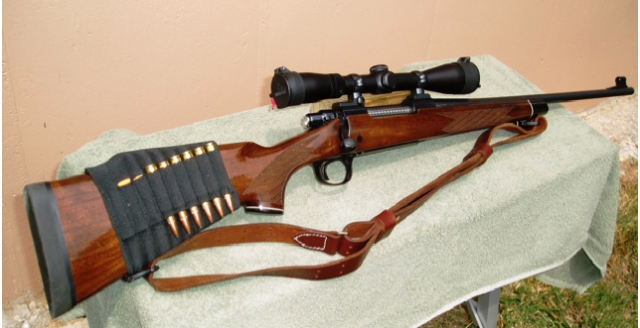
A Remington Model 798 bolt action hunting rifle chambered with 30-06 Springfield cartridges, and with a Bushnell rifle scope. With Mossy Oak rifle buttstock cartridge holder.
Top 5 Ranged Weapons
- Bolt-action big game hunting rifle with suppressor/silencer and scope
- Crossbow (with minimum 150 lb draw weight, and 20 inch bolts rated at 150lbs +), and scope, OR a Compound bow / Recurve bow / Longbow rated at 65 lbs + draw weight and minimum 24″ arrows
- Slingshot / Wrist rocket with steel ball bearing bullets
- Pump-action shotgun – 12 gauge with 22″ barrel, 18″ preferred, with 70 mm or 2.75″ 12 gauge 00 (double-aught) buckshot shells with 9 pellets each
- Heavy caliber handguns (.357 Magnum, .44 Magnum, .45 ACP)
Medium to Long range sniping: For a sniper-action against zombies, a good bolt-action big game hunting rifle with a scope and suppressor will be perfect for reaching out and dispatching zombies at ranges up to 400 yards. However, despite the ability, targets at 200-300 yards provide a better chance of hitting, and an easier kill. A suppressor is necessary if you don’t want to draw the attention of zombies and other roving bandits. Also, note that a suppressor may not be legal in your local area. In that case, you may want to use improvised methods to reduce the muzzle flash and sound reverberation.
Shorter range attacks: An average person can use a crossbow with a scope to hit a bulls-eye up to 70 yards, but will have a better chance hitting a bulls-eye at 30-40 yards. A Compound bow, a recurve bow, or a longbow will have a similar range. A slingshot could hit a target up to 40 yards, but will be more effective at 10-20 yards range. A shotgun, a pistol or a revolver will be effective against targets up to 50 yards, but will be more effective at 20-30 yards range. When zombies break through your defensive parameter within 10 yards, the better option is to run. If running is not an option, or you are trapped, then you will need to switch to your melee weapons.
Notes on buying
Bolt-action big game hunting rifle: This rifle is to serve as a “one-shot, one-kill” ‘sniper’ rifle against zombies at a range of 200-300 yards, and as such, it requires long range accuracy, and stopping power. Smaller caliber bullets “may” do the trick, but when you are knee-deep in zombies, “may” just won’t do, hence, I opt for .30 caliber plus. There are so many civilian brands out there, and with so many different calibers (inner diameter of the barrel) and cartridge (bullet and casing) types, it can be hard to decide. To make it simple, pick a hunting rifle that fires a common and inexpensive but reliable and accurate cartridge. I will use a 150 grain bullet as a standard for the purpose of zombie hunting, for all calibers discussed here. For example, the .30-30 Winchester cartridge is the ‘entry level’ common cartridge for big game hunting, and it has been around for a long time. That said, .30-30 is not suited for targets at ranges above 200 yards, and should only be used for sniping within 70-150 yards for effectiveness. The .308 Winchester cartridge is a more powerful cartridge, is pretty common and known to be reliable and accurate at longer range, and it is the civilian version of the 7.62 x 51 mm NATO cartridge – not the NATO cartridge itself. A similar cartridge .30-06 Springfield (7.62 x 63 mm) is comparable to the .308, and is known to have a little bit more power and a bit more velocity – it is the former US Army standard cartridge until early 1970’s. If you want an even better performance (more power, velocity, and longer range), you can choose the .300 Winchester Magnum cartridge for more money. You will need to pick which gun will fit your budget and expectations.
Whatever the case, you can get a good reliable rifle for under $1,000, scope included (Some may cost a bit more). Best results will be achieved by aiming at 90 degree angles to the skull, and better yet, to aim through the eyes for maximum penetration. Understand that most big game rifles will weigh between 6 and 9 lbs, and the heavier rifles are more stable and reduces recoil kickback. Wood stocks are generally more expensive than composite (synthetic) stocks.

Left to right: .30-06 Springfield, .308 Winchester, .30-30 Winchester
Warning: Always wear eye and ear protection when firing firearms. Protect your eyes from gases and gunpowder discharge, flying debris, dust, and ejected shell casings from the gun. Protect your ears from the loud bang, which can cause temporary or permanent hearing impairment or loss after repeated firing of the gun. Especially when firing a gun from inside a room or hard enclosure, the sound waves can reverberate and cause more hearing damage. Just because you can hit a target at 600 yards does not mean that you can kill the target at 600 yards. The maximum effective killing range will be much lower than the maximum range of the rifle and the cartridge.
Suppressors/silencers: First, dispel the myth that suppressors are ‘whisper quiet’ and make you as stealthy as a ninja assasin. No, it will only reduce the sound to a less offensive pop – about as loud as a clap. If it is legal to acquire a suppressor for your rifle, please do, since it will do a lot of good for you. 1) It will save your hearing. 2) It will protect your eyes from muzzle flash and flying debris, 3) It will reduce your gun’s recoil. 4) It will make you less of a target. Note that a suppressor can cost as much as the rifle, and in some cases, even more expensive.
Calibers
Heavier caliber rifles: There are several reasons I only mentioned rifles in the .30 caliber range. 1) .30 caliber is all you need to penetrate a zombie skull. 2) .30 caliber is widely available, and inexpensive. 3) heavier caliber guns such as .338, .375, .40’s, .416, .425, .45, .458, and .50 caliber range guns produce a significantly higher recoil, which can hurt your shoulder. 4) heavier caliber cartridges are also more expensive. 5) heavier caliber cartridges are, well, heavier to carry around. 6) heavier caliber cartridges require more gunpowder to reload. 7) heavier caliber guns will create a louder bang, and a bigger flash, which will cause you to flinch, or cause temporary vision impairment, and attract unwanted attention. 8) It’s overkill. You just don’t need that much power. 9) The repeated firing can cause damage on your shoulders, ears, and eyes.
Lighter caliber rifles: Yes, there are lighter caliber rifles that can penetrate a zombie skull (at a certain distance). Yes, they are much kinder on recoil. Yes, they are lighter, so you can carry more. But that’s all the advantages it has. A .30 always has much more stopping power than a lighter caliber, and .30 caliber bullets are quite common, and easy to find. A .30 also has an extra 100 yards further effective range than a lighter caliber bullet, with the exception of the .270 Winchester. That said, if you already have a .223 Remington caliber rifle, then use the 55 grain or heavier cartridge with muzzle energy of around 1300 ft lbs, which is very close to the 5.56 NATO cartridge specs, but instead use it for hunting zombies at a range up to 100 yards instead of 200 yards. The 5.56 NATO round (same caliber as .223 Remington) is designed with higher pressure does have the power to penetrate a zombie skull at 200 yards or more. If you have a rifle that can chamber and fire a 5.56 NATO, then you should use that rifle, with a scope, and use it for head shots at 200 yards range. My research shows that such rifles are normally above $1000 range for new guns. If you can get a good 5.56 NATO semi-auto rifle for under $1000, then go for it. I would recommend a rifle with 18-20″ barrel for the purpose of long range zombie hunting for the 5.56 NATO cartridge.

Left: .223 Remington/5.56 NATO cartridge. Right: .308 Winchester/7.62 NATO cartridge.
Semi-automatic and automatic rifles: These might be useful to slow down zombies by spraying bullets at them, or to reduce their mobility, if you are on the run. For accuracy and sniping action, and for ammo conservation, I prefer the bolt action. If you already have it, then great, use it with a scope for single rounds only, at 200 yards. Otherwise, if you haven’t bought one yet, I would recommend that you get a bolt action hunting rifle instead, which will likely be several hundred dollars cheaper, if not more, and use the difference to buy ammunition.
Lever action rifles: I have nothing against lever action rifles. I think they are somewhat similar to semi-automatic rifles in usefulness – when you are on the run, and you need to shoot from the hip, they might be useful to shoot a couple of quick rounds at zombies to slow them down, but that’s about it. For tactical retreat scenario, I would rather use the shot gun, since it will do the same trick, and give you a good chance of blowing off a zombie’s head by aiming in the general direction.
Crossbows: With a rifle stock and a pistol grip, the crossbow may feel like a rifle, but it is not. It has a shorter effective range, and much slower velocity, and behaves more like a bow than a rifle. It can hit a target at 60 yards, but at shorter ranges (30-40 yards), it can be an effective, low noise weapon for perimeter defense. There are a lot of crossbows rated at 150 lb draw weight, and enough bows rated at 175 lbs that if you could get your hands on a heavier draw weight one, get it. A good crossbow would set you back between $100 to $500, but there are also cheaper bows as well as more expensive bows. As you can understand, the cheaper bows (under $100) will be made of cheaper materials, and will not be as reliable and stay accurate for the long run. That said, if you want a good quality crossbow, be prepared to shell out up to $500. Although I am not a big fan of the crossbow – I am a recurve bow fan – I think the crossbow will be somewhat easier to use than a recurve bow for the average person, and would be better suited. My pick for the crossbow of choice would be the Barnett Penetrator – it is a heavy 175 lb draw crossbow, and it comes in a package with a 4 x 32 scope and a set of 3 x 20″ crossbow bolts, and a rope cocker. Plus, it comes with a 5 year warranty. You will need to invest in getting more crossbow bolts and broadheads for ammunition, and I’m sad to say they are not cheap. Also, if you need a better cocker to reload your crossbow, try this Barnett Universal Crossbow Crank Cocker – it will make your life easier, and your hands and arms will thank you. The Barnett Penetrator will kill a zombie just as dead as the famous Stryker Strikezone 380 crossbow that is used by Daryl in Walking Dead, and save you a couple of hundred dollars which you can use to invest in crossbow bolts. Check your local laws if a crossbow is legal for use or possession in your area.
Warning: The manual crossbow requires loading before every shot, and it requires some strength to reload the bow, by pulling the string manually, or with the aid of a rope cocker. The heavier the draw weight of the crossbow, the stronger you will need to be to successfully reload the crossbow. This reloading action cannot be done easily while on the run, and therefore, the crossbow should not be used if you need to be on the move. Preferably, you should be on high ground with a stable platform to aim, shoot, and reload the crossbow, just as a deer hunter would hunt from a hunting platform.

Barnett Penetrator 175 lb draw weight crossbow with scope
Recurve/Compound/Longbows: A heavy draw hunting bow at a draw weight of 65 lbs minimum will provide sufficient power to put a broadhead arrow through a zombie’s skull. As an alternative to the crossbow, if you are a proficient bow hunter, or has practiced with archery, the recurve/compound/or longbow can be a viable alternative or replacement for the crossbow. However, a crossbow is better suited for someone who is not familiar with archery or bow hunting. The modern compound bow delivers the power of the recurve and the longbows with less length by using modern technology and pulley system similar to the modern crossbows. While the recurve and the longbow requires a direct pull strength, the modern compound bow multiplies your pull weight, and thus is more forgiving on the arms. Wizard Archery – 70 lb draw Compound bow delivers the technology and power for a fraction of the cost of the brand name bows, and will not break your bank ($180). It also has an adjustable draw weight from 55 to 70 lbs. You will need a sufficient supply of 31″ arrows with up to 70 lb draw weight to handle the powerful bow, with screw-in 100 grain broadheads. The effective range for the compound bow is 40 yards.
Warning: The arrows that you buy must have the spine weight to match the maximum draw weight of the bow, and also must be longer than the maximum draw length of the bow. For example, if the maximum draw weight of the bow is 70 lbs, the arrow spine weight must be 70 lbs, or more. Otherwise, it will break or split upon impact, or reduce accuracy. If the maximum draw length of the bow is 30″, the arrow must be at least an extra inch longer to be safe, at 31″. An arrow shorter than the draw length will not fly, or cause serious injury to the archer. Never dry-fire your bow (pull and release the bow string without an arrow in it). It will weaken the limbs and string and mechanisms and can eventually cause the bow to fail or malfunction. Never point a loaded arrow at a friendly comrade. Treat it as a loaded gun when you have an arrow nocked, especially if it is a broadhead tipped arrow. Never point the arrow at your feet.

Wizard Archery – 70 lb draw Compound bow
Compound bow and arrow vs. Zombie head – by Zombie Go Boom a YouTube video – a test strike with a compound bow to put an arrow through a human skull analogue.
Slingshots: The slingshot is a significantly cheaper and shorter range weapon, and is effective and accurate against targets within 5-10 yard range, and has enough power to penetrate a zombie skull at that range. Use this weapon as a backup ranged weapon as a companion to the crossbow or a recurve/compound/longbow if you are safely up on a platform where zombies cannot reach you. The advantage of the slingshot is that it is relatively a quiet weapon for short range attacks, and you can nearly use any small pebble or steel bolts you find as bullets when you run out of the steel ball bearings. This Daisy Outdoor Products “Powerline” – P51 Slingshot doesn’t have bells and whistles, but will provide a solid short range primitive and low noise attack capability. It comes with an extra replacement band and some ammunition (See some reviews of this slingshot on YouTube Here, and Here). Just make sure you have plenty of ammunition – steel ball bearings. You may need to fire more than one against a zombie. May not be legal in your local area (NJ, for instance).
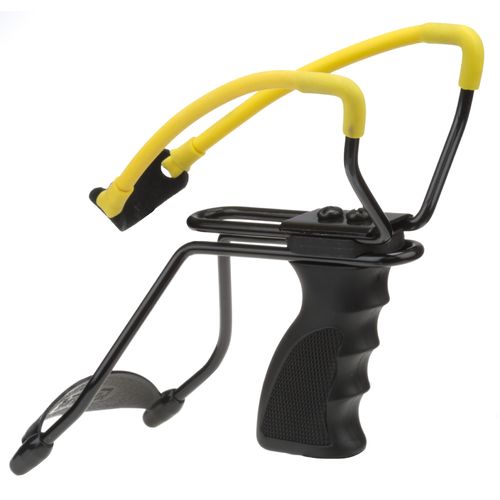
Daisy Outdoor Products – P51 Slingshot Kit

Remington 870 Express 12 gauge 7 round pump action shotgun
Shotgun: The 12 gauge shotgun is ubiquitous in many zombie movies. I included this in my top 5 ranged weapon list. The shotgun is good for a few uses. 1) Using it on the run to either slow down or stop some following zombies. 2) Breaching doors with a special breaching round. This should be a ‘fall-back’ or backup weapon. It would be effective against stopping 2 or 3 zombies following you, or slowing down 4 or 5 zombies that are following you. You may need to fire 2 shots per zombie to stop a zombie dead, both shots placed in the head. You should switch to this ‘fall-back’ weapon when more than 1 or 2 zombies have breached your perimeter or broken through within 20 yards, and you need to fall-back to a safer zone, or run. My suggested shot type is the 00 buchshot with 9 or more steel pellets per cartridge for stopping zombies, and a special breaching round for breaching doors. The drawback is that when you use any type of gun, the sound will attract unwanted attention, and when inside rooms, can cause some hearing impairment. My pick for this pump action 12 gauge shotgun is the Remington 870 Express 12 gauge 7 round Home defense shotgun. It is the trusted and reliable Remington brand with a 6 round magazine and 1 in the chamber, and an 18″ barrel for under $500. If you want a cheaper brand with similar specs, you can look at the H&R Pardner Tactical shotgun, for under $250. Don’t forget to load up on the 12 gauge 00 buckshot with 9 pellets each.
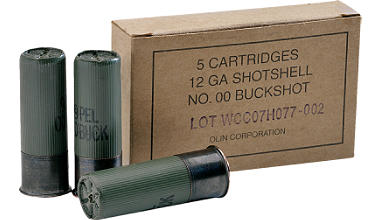
Winchester Military Grade 12 gauge 00 buckshot with 9 pellets each.
Heavy caliber handguns: The pistol or revolver will be your last ranged weapon after you have fired all your shotgun shells at the oncoming zombies. After the pistol or revolver has fired all rounds, you will need to switch to melee weapons. You have no time to reload your shotgun, and you need to keep moving, so you pull out your last-ditch fall-back ranged weapon when the zombies get within 10 yards. There are a few calibers I recommend that has enough stopping and popping power. The .357 Magnum, .44 Magnum and the .45 ACP cartridges have the stopping power to take down the approaching zombies. At this distance, you can pretty much empty all your rounds in your clip or revolver chamber before you switch over to melee weapons.
Note on 9 mm rounds: The 9 mm Parabellum round is a very common round, and can be easy enough to find, has significantly less recoil, and is much lighter. However, it does not have enough stopping power, and although it makes a fine round for general survival and self-defense needs against bandits and such, it falls short in stopping zombies. That said, if you are a crack shot with a 9 mm handgun, and can do head shots 9 times out of 10 at 25 yards, then by all means, use it. I just would not recommend it for an average person for the zombie apocalypse.
Please Like, Comment, and/or share. Thank you!
Check out my YouTube Channel for related videos: https://www.youtube.com/user/taoofsurvival


